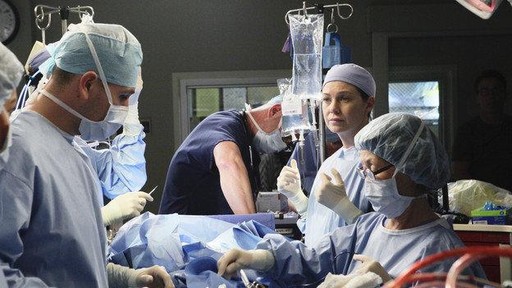
Aortic Dissection
Both talented men died from delayed diagnoses of aortic dissections. Relatively uncommon, it's a life-threatening condition in which a tear develops in the inner layer of the aorta—the main and largest blood vessel branching off the heart. When a tear occurs, blood rushes through into the middle layer, causing the middle and inner layers to separate (dissect). The separated layers aren't meant to hold the forceful amount of blood rushing through which can cause the aorta to rupture—a fatal condition.
Even though Oliver Richter did not lack adequate care or attention at Seattle Grace Mercy West Hospital, he also did not survive an aortic dissection. As Episode 715 "Golden Hour" only takes place over the time period of one hour, Oliver's case shows how even when the diagnosis is not delayed, an aortic dissection can be deadly.
What types of symptoms may suggest an aortic dissection?
Well, as seen with Oliver, the main symptom is severe and sudden chest or back pain. Patients can literally describe the pain as "tearing." And as the dissection gets worse, the pain only intensifies. Oliver does tell Meredith he feels better after some time, but he also desperately wants to get discharged in order to take his son to a basketball game.
Other reported symptoms include:
- Shortness of breath
- High blood pressure
- Sweating
- Loss of consciousness (fainting)
- Weakness and paralysis
- Different pulse rates in each arm
- Stroke
Why do people get this?
The main cause for aortic dissection is unknown, but doctors believe that several factors put patients at risk. Even though anyone may experience the condition, men (near the age range of sixty to seventy) seem to be more prone than women. According to the American Heart Association, the male to female ratio ranges from 2:1 to 5:1. Chronic high blood pressure and atherosclerosis might contribute to aortic dissection as well—the elevated pressure and hardening of the arteries could stress the aortic tissue making it more susceptible to tear. The following aortic diseases may be related: aortic dilation, aortic aneurysm, congenital aortic valve abnormalities, and coarctation of the aorta. Other risk factors include: pregnancy, genetic diseases (such as Marfan syndrome, Ehlers-Danlos syndrome, Turner syndrome), cocaine users, and blunt trauma to the chest.
Why is it difficult to diagnose?
If you read the symptoms listed, many indicative signs mimic multiple health problems and need more specific imaging to make a clear diagnosis of an aortic dissection. Many doctors suspect the dissection from the following: the description of the chest pain as "tearing," a blood pressure difference in the left and right arms, and a widening of the aorta on a chest X-ray. However, since different ailments require different treatments, it is important to narrow the diagnosis as much as possible. Imaging techniques frequently used include: a CT (computerized tomography) scan, an MRA (magnetic resonance angiogram), and TEE (transesophageal echocardiography).
How are aortic dissections treated?
First, it would be helpful to distinguish between the two different types of aortic dissection: Type A and Type B. A Type A dissection (the more common and dangerous type) describes a tear in the ascending portion of the aorta near where it leaves the heart or a tear running from the ascending portion down to the descending aorta, which may reach into the abdomen. Type B entails a tear in the descending portion, which can also extend into the abdomen.
If someone suffers from a Type A dissection, he or she will require surgery to remove as much of the dissected blood vessel as possible, stop the flow of blood into the aortic wall, and rebuild the aorta with a synthetic tube (a graft). And if valve leakage is also present with the tear, the aortic valve will need to be replaced during surgery also.
Now patients with Type B dissection can undergo medical therapy as well as surgery. The surgical options seem very similar to the procedures prescribed for the Type A dissections. The only difference is that stents often may be placed in the aorta as a scaffolding device for repair in Type B dissection repairs.
Medical therapy can involve beta blockers and sodium nitroprusside to reduce the patient's blood pressure and heart rate, thus lowering the stress on the aortic wall.
However, both types of patients usually need to take blood pressure lowering medicine for the rest of their lives as well as require follow-up imaging to monitor their condition.
How do you keep this from happening???
Well, the best rules to follow for prevention include:
- Wear a seat belt to prevent blunt trauma to the chest.
- Don't smoke.
- Control your blood pressure.
- Watch your cholesterol.
- Maintain a healthy weight.
- Let your doctor know what's going on with you.
For more information on aortic dissections, please visit:
http://www.nlm.nih.gov/medlineplus/ency/article/000181.htm



